ReFS, or Resilient File System, is Microsoft’s latest file system introduced for the standalone and Server versions of Windows. However, if you receive an error message saying ReFS volume repair was not successful in Windows 11/10, follow this post to fix the problem.
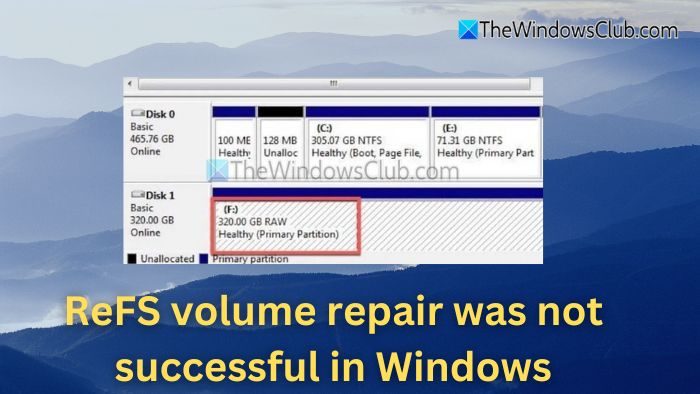
What happens when ReFS Volumes repair isn’t successful?
ReFS stores data and accompanying information (metadata) using a digital fingerprint or checksum to ensure its functioning and data safety. However, the integrity stream is disabled by default at the disk volume label.
ReFS volumes appear as RAW
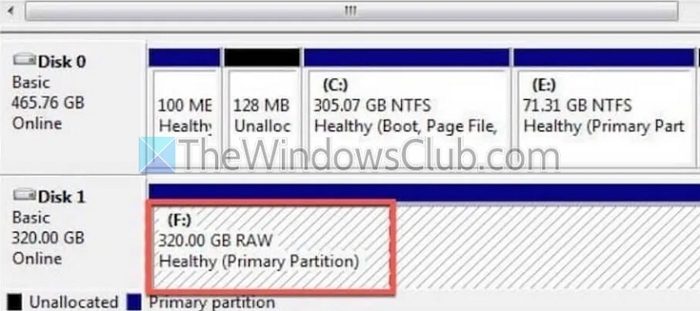
If the ReFS volume repair fails, one of the most common symptoms of the failure is the ReFS partition appearing as RAW in the Windows Disk Management utility. In case of such failures, we can carry out the below-mentioned steps to restore the data to an external device:
- Connect the external drive to the PC or laptop through the USB port and open the Run dialogue box by pressing the Windows+ R keys together.
- Type cmd and press Enter to launch the Windows Terminal.
- At the Terminal Prompt type,
refcp D:\Data F:\Backup /status
Here, F:\ Backup represents the drive letter of the external drive, and Backup would be the folder u der which the restored data from D:\Data ( source path) would be backed up. The /status switch can also be used optionally to view the transfer status in real time.
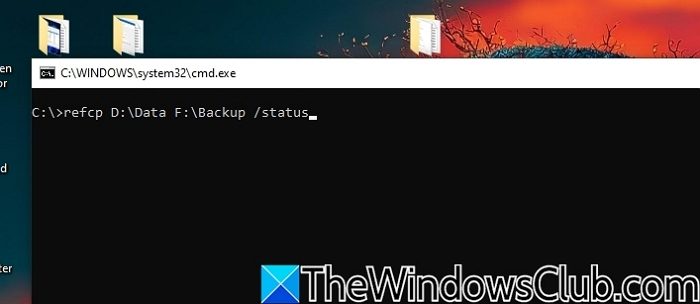
Once the data backup is completed, we can re-format the volume as ReFS for further use.
Cannot mount ReFS volumes or drive not showing
Drive mounting is the process wherein internal or external storage devices are made accessible to the OS installed in the PC or laptop once it’s physically attached to it. Once mounted, the OS assigns a drive letter dynamically ( D:, E:, F: etc ). However, if the ReFS Volume remains damaged after repair, the said volume may not be visible, or Windows may not recognize it, causing mounting issues. To resolve the problem, we can adopt the below-mentioned solutions :
Run the chkdsk utility to check and fix the volume for errors from the Windows Terminal by typing:
chkdsk /f /r D:
D: represents the ReFS volume, and /f ensures that any structural issues if detected, are fixed. The /r is used to detect the corrupt portions of the volume and recover the data from the corrupt areas to put them at the location of the drive, which is not damaged or corrupt.
We can also attempt to mount the drive forcibly through cmdlets in the Windows Terminal as an alternate step. To do so, we can type:
mount D: /f
D: is the ReFS drive, and /f ensures that the system mounts the drive forcibly, even if the volume is partly corrupt. Once mounted successfully, we can restore the data and re-format the drive to ReFS.
ReFS volume repair was not successful in Windows 11
In the event of a failure to repair a ReFS volume, the below-mentioned steps can be carried out to fix the issue:
- Use Windows PowerShell Commands
- Allow or Enable File Integrity Streams
- Use ReFSutil
1] Use Windows PowerShell Commands
If we are trying to repair a ReFS disk volume for which we do not have any backup, we can still use the Windows PowerShell cmdlets to repair the volume as an alternative. To repair corrupted volume:
- Open the Windows PowerShell by typing the same in the Desktop Search Bar and clicking on the first search result.
- At the PowerShell prompt type,
Repair-Volume -DriveLetter E -OfflineScanAndFix
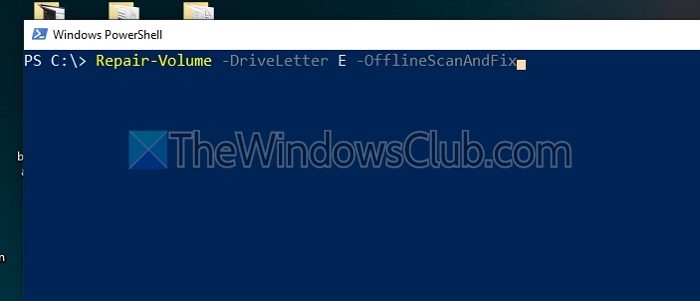
The above cmdlet takes the offline E: drive volume and attempts to correct the existing errors through OfflineScanAndFix. Once completed, the volume is automatically brought online. Multiple volumes can also be repaired in the same way by mentioning the drive letters as shown below:
Repair-Volume -DriveLetter GHI -Scan -SpotFix
Apart from the OfflineScanAndFix option, we can also use -Scan and -SpotFix to detect and repair ReFS volumes. In this example, the mentioned volumes ( G:, H:, and I:) are scanned for errors, and any errors found are added to a system file. The -SpotFix option then checks the same system files and repairs the corrupt entries mentioned in the file.
Read: Fix REFS_FILE_SYSTEM Blue Screen error on Windows
2] Allow or Enable File Integrity Streams
Even though ReFS uses an integrity scrubber mechanism to track and repair data corruption automatically, the mechanism may occasionally fail to detect the problem.
ReFS volume Repair may fail due to data corruption or file system errors. In such cases, enabling File Integrity Stream increases our chance of successfully repairing the volume and minimizing data loss. To enable it using Windows PowerShell:
- Open the Windows PowerShell by typing the same in the Desktop Search Bar and clicking on the first search result.
- On the PowerShell prompt type,
C:\> Set-FileIntegrity H:\ -Enable $True
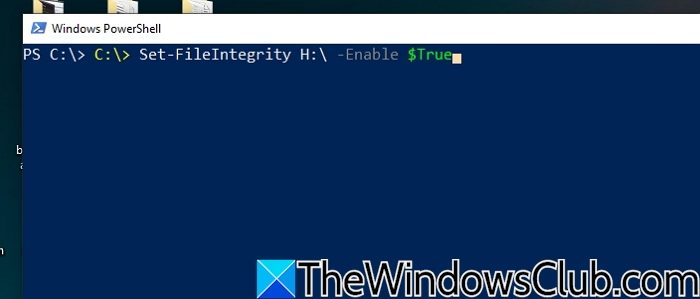
where H:\ represents the disk volume for which File Integrity is enabled.
Read: ReFS volume inaccessible after update
3] Use ReFSutil
ReFSutil is a Windows command-line tool that detects damages in ReFS volumes, identifies files that are not yet damaged, and transfers such files to different volumes. It uses the salvage function for the said process, which has two distinct phases— the Scan and Copy phases. The phases can be executed one after another manually by executing the below-mentioned commands:
refsutil salvage -QA D: C:\Temp C:\Recovery
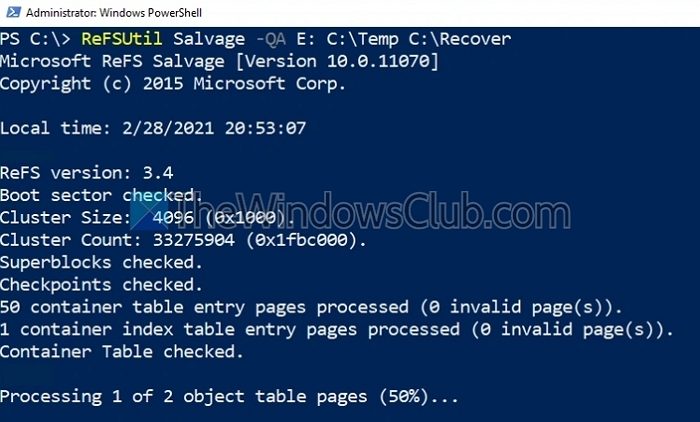
Quick Scan (QA) can be performed for the concerned volume (D:), where the working directory is C:\Temp and C:\Recovery is the target directory. Working Directory refers to the folder that the utility would use to store the log and temporary files during the extraction process. The target directory indicates the folder path to store the recovered files.
Note: The Volume Shadow Copy service should be running to ensure the ReFS utility and the salvage function are working.
Does chkdsk work on ReFS?
Unlike traditional file systems like NTFS, ReFS employs self-healing capabilities. It can automatically detect and correct errors using checksums, making CHKDSK scans unnecessary.
How much memory is needed for ReFS?
To optimize ReFS performance, it is generally recommended that 0.5GB of RAM be allocated for every terabyte of ReFS storage. However, this scaling isn’t linear. For ReFS volumes under 200TB, 128GB of RAM is often adequate, considering both OS and ReFS requirements.
Leave a Reply